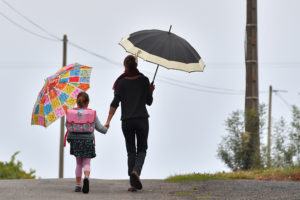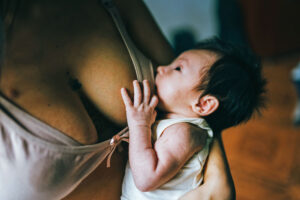Books or babies? It’s a choice that has presented itself to women writers for centuries. And it was a favourite theme of Ursula K. Le Guin who struggled, successfully, to balance the two. In her lecture, “The Fisherwoman’s Daughter”, published in 1988, she takes an optimistic view. “The Victorian script calls for a clear choice — either books or babies for a woman, but not both.” She chose both. She had had, in her own words, “three kids and written about 20 books, and thank God it wasn’t the other way round”.
This was a joke I often used to make in my own ever-evolving lecture about women and writing. I used to say, “I wrote my first three novels while expecting my first three babies,” and would then outline the challenge I had writing my fourth novel without being pregnant. Eventually, I got tired of this attempted witticism and dropped it, but it did no more than record a fact. Men might have thought it an impertinent fact, but it meant a lot to me, as pregnancy and childbirth seemed so intimately connected with my career and writing life.
In her lecture, Le Guin discusses an episode in my third novel, The Millstone, in which the narrator, Rosamund, describes how her baby has chewed up quite a lot of her flatmate’s novel-in-progress. Le Guin makes the point that the tone of this scene is comic and accepting rather than bitter or tragic. Both women survive it without acrimony: babies do eat books, and, as she says, and it is terrible, “but not very terrible”, because a book can be Sellotaped together again. And the babies “are only babies for a couple of years, while writers lived for decades”. I loved that description; she keenly understood the minor hazards of the writing mother’s life, the interweaving of books and babies.
I so well remember the birth of my son Joe in 1965: as I lay in bed with this very new baby I received a proof of The Millstone’s enchanting dust jacket by Quentin Blake. The two events are closely linked in my memory and will ever remain so. No choices, no contradictions there.
And yet. And yet. During the Sixties and Seventies, my speeches about Women and the Novel often included long lists of female predecessors who had had no children, and who did indeed seem to “sublimate” their creative activity into writing (partly because no other professions were open to them): Jane Austen, George Eliot, the Brontes, Dorothy Richardson, Willa Cather, Katherine Mansfield, Virginia Woolf (whose 1931 talk on “Professions for Women” gave Le Guin her eponymous fisherwoman’s daughter). My interest here was largely sociological. I was interested in pointing out the changing demographic of women writers, as authors such as Fay Weldon, Nell Dunn, Margaret Forster and I began to emerge in the Sixties.
I, like Le Guin, sought for women in history who wrote about domestic experience. I was particularly pleased when I found, in Elizabeth Gaskell’s letters, advice to a correspondent asking how best to organise her time if she wished to become a professional writer. Gaskell, who raised four children and lost two, replies that it is very useful to soak the washing overnight, as this lessens the time spent in the morning. In that moment she felt very close, as though she lived in the same world as I did, though I assume she had servants to help her.
Another successful writer who appealed was George Sand, immensely prolific, sexually adventurous, and a loving mother: she said that of the three main components of her life, she put her children first, her books second, and her lovers third. That seemed to me an admirable attitude. She didn’t go in for self-restraint, but she had her priorities.
In her lecture, Le Guin quotes extensively from Tillie Olsen’s influential study of marginalised writers, Silences, which I had not read until The Fisherwoman’s Daughter prompted me. I had been afraid it would silence me. I assumed its thesis was that women had been largely silenced by domesticity, a thesis that I obscurely but strongly felt would have negated my life’s endeavour. I feared that if I were to read that I had been silenced, I would be tempted to become silent.
Perhaps it illustrates how precarious my sense of self was, how lacking I was in what some might call ontological security. I suspected, quite wrongly, that Olsen took an adversarial view of literature — men triumphant and oppressive, women passive and oppressed. I had assumed that she shared the aggressive views of some of the early feminist critics of that period, whom I found disturbing — Kate Millett on the patriarchy and the faults of the family in Sexual Politics and Shulamith Firestone, who memorably and to me offensively compared childbirth to “shitting a pumpkin”. I didn’t want to be part of that ill-tempered debate, and I had thought Olsen might drag me into it.
How wrong I was about this open-minded and inclusive survey not only of women’s silences but of men’s. Olsen writes movingly of the silences and struggles of Herman Melville, Thomas Hardy, and G. M. Hopkins, marginalised by penury, censorship and the demands of a religious vocation respectively. She also sympathises with Joseph Conrad. But Le Guin takes her to task on this: she concedes that Conrad may have “wrestled with the Lord for my creation…a lonely struggle in a great isolation from the world” but all this while, food was being put before him and life was being made easy for him by “a silent, watchful, tireless affection”. His wife, presumably, although she is not named. Is that better or worse, more selfish or more unselfish, than Henry James’s dream of the Great Good Place, where invisible hands would wait upon him in a kind of country house or club — “a vision of soundless, simple service”? James was much coddled and liked to eat three coddled eggs for breakfast. Would I have written more and better if somebody had coddled me?
I suspect not. Domesticity was my subject, it was what I had in common with other women, it was what gave me a sense of the lives of others. Writing at the kitchen table kept Harriet Beecher Stowe in touch with daily realities, although it gave her little free time for work. Le Guin embraces the values of the domestic life, repudiating Nina Auerbach’s view (which she had once accepted) that Jane Austen was able to write because she had “created round her a ‘child-free’ space”. We know, as Le Guin points out, that Austen was very important to her nephews and nieces, with whom she played happily, and whom she comforted when they suffered loss.
Le Guin’s reasons for trying to accept Auerbach when she was younger are interesting: she had been taught that her own experience “was faulty, not right — that it was wrong. So I was probably wrong to keep on writing in what was then a fully child-filled space.” Maybe it was something like this that prevented me from reading Olsen when she first appeared.
Yet Olsen mentions Doris Lessing several times: one of my own inspirations partly because, as she wrote, “Whole areas of me are made by the kind of experience women haven’t had before.” I felt the same. She wrote about sexual freedom, loneliness, independence, standing alone and taking control of one’s own life. She valued the domestic as a subject, motherhood as a subject. She was a good friend of mine, and although we talked about books, we also talked about kitchen matters: she it was who pointed out to me that my kitchen shelving was in the wrong place. How she knew this I do not know, as her own domestic life was chaotic. Generous and sociable, but chaotic. But Lessing and I shared the belief that women’s lives were important. And that was one of the reasons why people wanted to read us. Had we been honorary men, disguising ourselves under male pseudonyms or gender-free initials, what new things would we have had to say?
Lessing, of course, is a problematic example of motherhood, but so are we all. None of us gets it right, just as most of us feel we haven’t got our novels right. But Lessing didn’t shy away from it or consider it of secondary importance. Le Guin, quoting Alice Ostriker, summons up the possibility of “the advantage of motherhood for an artist” and continues with Ostriker’s words: “we can imagine what it would signify to all women, and men, to live in a culture where childbirth and mothering occupied the kind of position that sex and romantic love have occupied in literature and art for the last five hundred years…” I feel that this culture is almost with us.
Almost, but not quite: it is easier to cite women who have written openly about sex, sexual orientation, menstruation and abortion than those who have written positively about childbirth. Some, like Sarah Moss, write intensely and brilliantly about the anxieties of parenthood, and Sylvia Plath wrote poems about breast feeding, which I used to quote in my lecture. But I continue to be surprised by the fact that “the Nursing Madonna” was considered a wholly suitable subject for art, while breastfeeding is still hardly ever mentioned in literature. We continue to inhabit a world of paradoxical values, one in which books and babies are not yet entirely compatible.
Disclaimer
Some of the posts we share are controversial and we do not necessarily agree with them in the whole extend. Sometimes we agree with the content or part of it but we do not agree with the narration or language. Nevertheless we find them somehow interesting, valuable and/or informative or we share them, because we strongly believe in freedom of speech, free press and journalism. We strongly encourage you to have a critical approach to all the content, do your own research and analysis to build your own opinion.
We would be glad to have your feedback.
Source: UnHerd Read the original article here: https://unherd.com/



